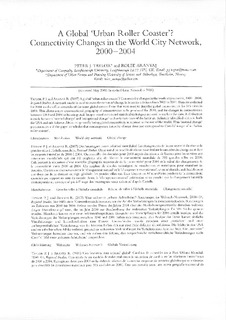| dc.contributor.author | Taylor, Peter J | nb_NO |
| dc.contributor.author | Aranya, Rolee | nb_NO |
| dc.date.accessioned | 2014-12-19T11:21:21Z | |
| dc.date.available | 2014-12-19T11:21:21Z | |
| dc.date.created | 2008-01-30 | nb_NO |
| dc.date.issued | 2007 | nb_NO |
| dc.identifier | 123400 | nb_NO |
| dc.identifier.uri | http://hdl.handle.net/11250/230990 | |
| dc.description.abstract | A global "urban roller coaster"? Connectivity changes in the world city network, 2000–2004, Regional Studies. A network model is used to assess the nature of change in intercity relations from 2000 to 2004. Data are collected for 2004 on the office networks of the same global service firms that were used to describe global connectivities for 315 cities in 2000. This allows a new cross-sectional geography of connectivities to be produced for 2004, and for changes in connectivities between 2000 and 2004 to be computed. Simple visualization and statistical techniques are used to explore the data. A distinction is made between "normal change" and "exceptional change" and only two cases of the latter are definitely identified: cities in both the USA and sub-Saharan Africa are generally losing global connectivity in relation to the rest of the world. Thus "normal change" predominates and the paper concludes that contemporary intercity change does not correspond to Castells’ image of an "urban roller coaster". | nb_NO |
| dc.language | eng | nb_NO |
| dc.publisher | Norges teknisk-naturvitenskapelige universitet, Fakultet for arkitektur og billedkunst, Institutt for byforming og planlegging | nb_NO |
| dc.title | A Global ‘Urban Roller Coaster’? Connectivity Changes in theWorld City Network, 2000–2004 | nb_NO |
| dc.type | Journal article | nb_NO |
| dc.type | Peer reviewed | nb_NO |
| dc.source.journal | Regional Studies | nb_NO |
| dc.contributor.department | Norges teknisk-naturvitenskapelige universitet, Fakultet for arkitektur og billedkunst, Institutt for byforming og planlegging | nb_NO |
